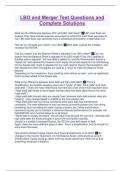LBO and Merger Test Questions and
Complete Solutions
What are the differences between DCF and LBO cash flows? ✅LBO cash flows are
levered. They have interest expense accounted for while DCF cash flows generally do
not. LBO cash flows also generally have a scheduled amortization of debt taken out.
How do you increase your return in an LBO? ✅More debt, expand the multiple,
increase the EBITDA
Can you explain how the Balance Sheet is adjusted in an LBO model? ✅Can you
explain how the Balance Sheet is adjusted in an LBO model? First, the Liabilities &
Equities side is adjusted - the new debt is added on, and the Shareholders' Equity is
"wiped out" and replaced by however much equity the private equity firm is contributing.
On the Assets side, Cash is adjusted for any cash used to finance the transaction, and
then Goodwill & Other Intangibles are used as a "plug" to make the Balance Sheet
balance.
Depending on the transaction, there could be other effects as well - such as capitalized
financing fees added to the Assets side.
What is the difference between bank debt and high-yield debt? ✅This is a
simplification, but broadly speaking there are 2 "types" of debt: "bank debt" and "high-
yield debt." There are many differences, but here are a few of the most important ones:
• High-yield debt tends to have higher interest rates than bank debt (hence the name
"high-yield").
• High-yield debt interest rates are usually fixed, whereas bank debt interest rates are
"floating" - they change based on LIBOR or the Fed interest rate.
• High-yield debt has incurrence covenants while bank debt has maintenance
covenants. The main difference is that incurrence covenants prevent you from doing
something (such as selling an asset, buying a factory, etc.) while maintenance
covenants require you to maintain a minimum financial performance (for example, the
Debt/EBITDA ratio must be below 5x at all times).
• Bank debt is usually amortized - the principal must be paid off over time - whereas with
high-yield debt, the entire principal is due at the end (bullet maturity).
Usually in a sizable Leveraged Buyout, the PE firm uses both types of debt.
Again, there are many different types of debt - this is a simplification, but it's enough for
entry-level interviews.
How would a dividend recap impact the 3 financial statements in an LBO? ✅No
changes to the Income Statement. On the Balance Sheet, Debt would go up and
Shareholders' Equity would go down and they would cancel each other out so that
everything remained in balance.
, On the Cash Flow Statement, there would be no changes to Cash Flow from Operations
or Investing, but under Financing the additional Debt raised would cancel out the Cash
paid out to the investors, so Net Change in Cash would not change.
How would an asset write-up or write-down affect an LBO model? / Walk me through
how you adjust the Balance Sheet in an LBO model. ✅All of this is very similar to what
you would see in a merger model - you calculate Goodwill, Other Intangibles, and the
rest of the write-ups in the same way, and then the Balance Sheet adjustments (e.g.
subtracting cash, adding in capitalized financing fees, writing up assets, wiping out
goodwill, adjusting the deferred tax assets / liabilities, adding in new debt, etc.) are
almost the same.
The key differences:
• In an LBO model you assume that the existing Shareholders' Equity is wiped out and
replaced by the equity the private equity firm contributes to buy the company; you may
also add in Preferred Stock, Management Rollover, or Rollover from Option Holders to
this number as well depending on what you're assuming for transaction financing.
• In an LBO model you'll usually be adding a lot more tranches of debt vs. what you
would see in a merger model.
• In an LBO model you're not combining two companies' Balance Sheets.
Walk me through how you calculate optional repayments on debt in an LBO model.
✅First, note that you only look at optional repayments for Revolvers and Term Loans -
high-yield debt doesn't have a prepayment option, so effectively it's always $0.
First, you check how much cash flow you have available based on your Beginning Cash
Balance, Minimum Cash Balance, Cash Flow Available for Debt Repayment from the
Cash Flow Statement, and how much you use to make Mandatory Debt Repayments.
Then, if you've used your Revolver at all you pay off the maximum amount that you can
with the cash flow you have available.
Next, for Term Loan A you assume that you pay off the maximum you can, taking into
account that you've lost any cash flow you used to pay down the Revolver. You also
need to take into account that you might have paid off some of Term Loan A's principal
as part of the Mandatory Repayments.
Finally, you do the same thing for Term Loan B, subtracting from the "cash flow
available for debt repayment" what you've already used up on the Revolver and Term
Loan A. And just like Term Loan A, you need to take into account any Mandatory
Repayments you've made so that you don't pay off more than the entire Term Loan B
balance.
The formulas here get very messy and depend on how your model is set up, but this is
the basic idea for optional debt repayments.
How would you adjust the Income Statement in an LBO model? ✅The most common
adjustments:
• Cost Savings - Often you assume the PE firm cuts costs by laying off employees,
which could affect COGS, Operating Expenses, or both.
• New Depreciation Expense - This comes from any PP&E write-ups in the transaction.




